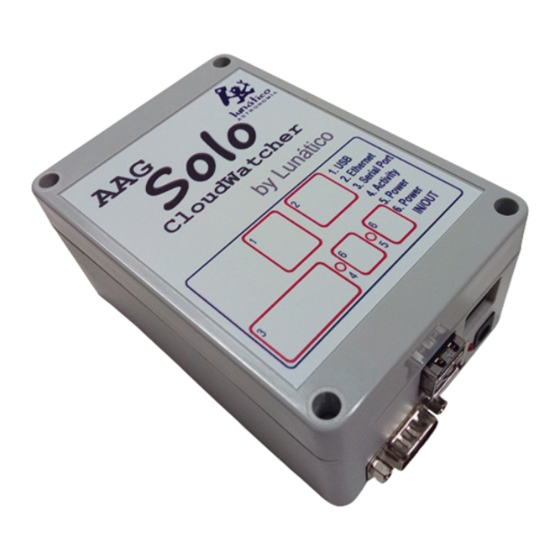
Advertisement
Quick Links
Advertisement

Summary of Contents for AAG Solo
- Page 1 SOLO SOLO Users manual Users manual SOLO - Users manual v. 1.4 30. Sep. 2016...
- Page 2 AAG CloudWatcher “Master” 2.5. Data logger (USB pen) Configuration “Hidden” features 4.1. Push notifications 4.2. Changing DNS server address 4.3. Rolling back to an older version Other interesting facts about the Solo SOLO - Users manual v. 1.4 30. Sep. 2016...
-
Page 3: Physical Installation
Solo to your local network using a standard RJ45 cable (not supplied) … that's it. In a few seconds the “activity” LED in the “Solo” will start blinking (slowly), showing it is communicating with the CloudWatcher SOLO - Users manual v. -
Page 4: Accessing The Data
Accessing the data Now that the “Solo” is up and running, and connected to your local network, it will fetch an IP address (automatically, using DHCP, as standard in the vast majority of networks) and start publishing information in a variety of ways. - Page 5 “NAT” rule for incoming connections at a given port to be redirected to the “Solo” – and of course the “Solo” needs to have a fixed IP address. You can check our running unit at: SOLO - Users manual v.
- Page 6 The “Solo” does publish this file, and thus you can add weather safety just accessing it from the network. Browse the network to the “aagsolo” computer (by the way, user “pi”, password “cloudwatcher”...
- Page 7 Forget the “tmp” folder, and go to the “AAGSolo” one: There are quite a few files, but it is “aag_sld.dat” (meaning AAG Single Line Data) the one we're looking for. There's also a file called “aag_sldc.dat”, being the same but with a comma “,” separating the decimal numbers.
- Page 8 Accesing the network in the same way, we can find a special file for the ScopeDome software, namely “scopedome.csv”: … just select this file in your ScopeDome software, Config, Cloud Sensor Config (Current Cloud Sensor Status File Name) SOLO - Users manual v. 1.4 30. Sep. 2016...
- Page 9 2.4) AAG CloudWatcher “Master” The “Solo” also behaves as a CloudWatcher Windows application in Master mode, so you can connect other instances of the Windows software, running as Remote, to the “Solo”. Note: to change your current Windows software from Master to Remote, you'll have to run a small utility called “AAG_ResetParameters”...
- Page 10 This is the file your “remote” AAG programs will need to operate. Selecting, from those applications, the folder containing it will allow them to run. As said before, depending on the Windows version, you may have to connect to the “aagsolo”...
- Page 11 Data Logger A new (for version 1.4) and useful feature of the Solo is its ability to record a CSV file in a user supplied USB stick. You just need to insert, in one of Solo USB ports, a suitably formatted USB memory stick (suitably formatted means FAT –...
- Page 12 You are in your local network, so please trust you're accessing your “Solo”. You'll be asked for user and password, in this case the user is “solo”, the password the same as before, that is, “cloudwatcher”.
- Page 13 Just a few notes about the configuration – please consult the online documentation for the Windows program for more specific data. SOLO - Users manual v. 1.4 30. Sep. 2016...
- Page 14 The System page is very straightforward, only worth noting is the Network configuration: … here we can specify if we just want the address of the Solo to be obtained automatically for our router (full automatic), avoiding any problem, or if we prefer to also specify a static (fixed) address, which is useful to make the Solo accessible from the internet.
-
Page 15: "Hidden" Features
“Hidden” features There are a number of interesting things the Solo can do that lack proper support in the configuration pages, for the moment, but still can be accessed. 4.1) Push via Pushbullet If you want the Solo to send push messages to your smartphone, PC, or whatever, now there is support for this using Pushbullet, a great and free system. - Page 16 Tip: to find out your current DNS, open a windows command prompt and type “nslookup”: … as shown above. The Address shown is your current DNS server (for your PC), and you can safely use it for the Solo, so it would be, for that address: https://aagsolo/cgi-bin/cgiSetDNS?194.224.52.36 4.3)
- Page 17 Other interesting facts about the “Solo” ✔ The “Solo” is based on the Raspberry Pi model “B”, and has a really friendly power consumption of approx < 2 W. ✔ Inside the box there's a SD card acting as the hard disk of the device. It is mounted in “read only”...
Need help?
Do you have a question about the Solo and is the answer not in the manual?
Questions and answers